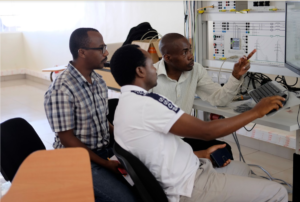In America it is easy to take access to reliable electricity for granted. Yet, according to the United Nations, 1.2 billion people around the world still live without power, and in developling countries, access to electricity is a luxury primarily available to those in metro areas. In the African nation of Rwanda, for example, the government estimates only about 20 percent of the country has access to electricity, and this figure was as low as 5 percent in rural areas in 2013.
The Rwandan government recently launched an ambitious goal to electrify the entire country by 2024 to bolster its economy and improve the health and incomes of its nearly 12 million residents, many of who live in remote rural areas, some hours from paved roads.
Running power lines from a national electric grid is not only costly but would only provide electricity to roughly half of the population. Instead, the Rwandan government is looking at smaller, community-based microgrids and small household systems that generate electricity on-site and distribute solar power to the end consumers.
Researchers at Colorado State University, in collaboration with the University of Rwanda and energy startup MeshPower, are helping the nation reach its electrification goals, through a large-scale project to design, build and install microgrids in rural villages.
Decentralized microgrids
“Microgrids are grids we build from the ground up, and don’t require a connection to the central grid,” said Bryan Willson, executive director of the Energy Institute at CSU. “In much of the developing world, we can’t afford to extend the grid because of far distances, and the amount of power we are supplying is relatively small. So, in those cases it makes sense to use things like solar, batteries, wind, or engines, to supply the power and distribute it within a village.”
Decentralized microgrids allow areas without access to bypass the national electricity network electric grid. Microgrids, in general, consist of an energy generation source and energy storage. Historically, both functions have been performed by loud and dirty diesel generators, but the Smart Village Microgrid team is using solar power and battery storage.
While solar power can be more expensive than retail grid-connected power, it is cheaper than extending the grid to households that are not currently connected. This makes microgrids an attractive option for the millions of people without electricity who have modest power demands.
Socio-technical implementation

However, technology isn’t the only answer to the challenge of rural electrification. Dan Zimmerle, senior research associate in the Energy Institute, says the key question is how to have socio-technical implementation of sustainable microgrids. Therefore, the Smart Village Microgrid team is incorporating sociology and economic impacts into their research, and working with Rwandan schools and companies like MeshPower.
Read more about the economic impact of microgrids in Rwanda.
“I think the approach we have taken at CSU to microgrids is different than what most universities have done,” said Zimmerle. “At most universities the microgrid work is entirely in the technical department. Our approach has always been cross-disciplinary.”
The Smart Village Microgrid team has been supported, in part by the Catalyst for Innovative Partnerships (CIP), a program of the CSU Office of the Vice President for Research that funds cross-disciplinary science. Through CIP, Zimmerle has collaborated with engineers, social scientists, industrial technology designers and others from the colleges of liberal arts, agricultural sciences, and health and human sciences.
Global partnership
The CSU team has also partnered with the University of Rwanda to replicate laboratory facilities and methods and are working to duplicate the design and development of engineering coursework.
“Colorado State was named as the strategic partner with the University of Rwanda in this African Center of Excellence which is funded by the World Bank,” said Willson. “In that role we have helped them to design the curriculum, to lay out the research programs, and create the laboratories including training of University of Rwanda staff at Colorado State.”
The program has also expanded to 10 additional countries in southeast Africa to continue training and education in areas that have significant electrification needs.